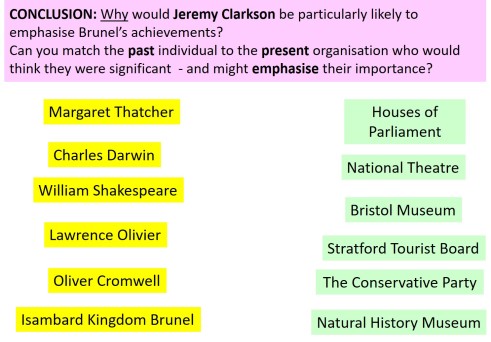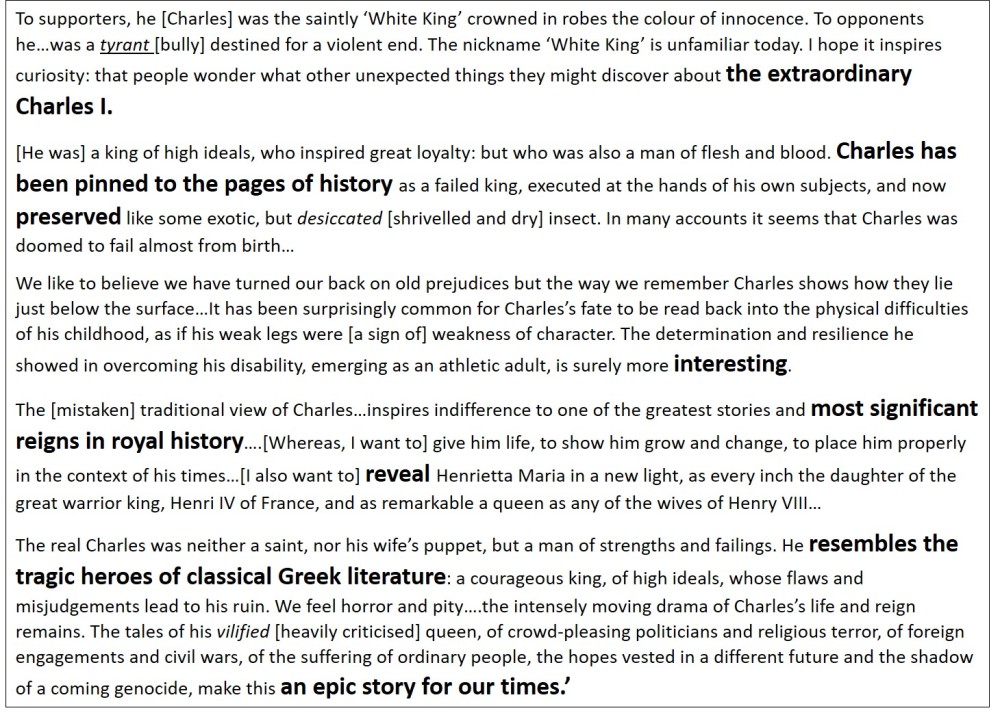This is one in a series of blog posts in which I show how a journal article or book has inspired me to improve my teaching practice. Each post ends with a practical resource or activity. Today I show how a ‘New, Novice or Nervous’ feature in the journal Teaching History (2016) and the book ‘White King’ by Leanda de Lisle (2018) kindled my enthusiasm about teaching a ‘hard’ second-order concept in the history classroom.

Jamie is an earnest, conscientious and diligent pupil; the sort that shoots his hand up with alarming alacrity on ‘get into teaching’ adverts. Annabel, meanwhile, is permanently chewing on the ends of an illicit jumper and her tie is ‘jaunty’ at best. They usually pretend that the other does not exist. Which is why, one mild Monday morning, I found their synchrony somewhat disturbing.
We were ending our Year 9 study of Isambard Kingdom Brunel by considering the question of Brunel’s significance. We first constructed some criteria of significance as a class, having reflected on the criteria that we had used in Year 7 and Year 8 (including Counsell’s 5 Rs). We then applied our class criteria to Brunel’s projects that we had studied. With reference to all criteria, such as ‘things changed’, we judged Brunel to be ‘significant.’
I was about to make a link between our study of Brunel and our next enquiry question on the topic of ‘protest’ yet I was interrupted by a vertical hand – Jamie’s, as usual. What was more frightening was Annabel’s vague hand resting casually on her hair (a raised hand was, in her eyes, beneath her).
Jamie: ‘So are we going to write an essay on this, Miss?’
Annabel: ‘Yes, what was the point of all that, Miss?’
Unusually, it was Annabel’s question that stumped me.
The second-order concept of historical significance is slippery. I can’t think of another word for it. It is so easy to succumb to presentism and relevance. It is so hard to arrive at a satisfactory set of criteria. It fell outside my regular arsenal of, for example: weighing evidence; constructing a narrative; creating a causal hierarchy; deciding upon historical turning points. I felt like I needed to force my thinking about significance, like a kitchen chore to get out of the way before being allowed a glass of wine.
I decided that some more reflection was required. What made me inwardly groan when anyone mentioned ‘significance’? I decided that I didn’t want to do anything with my enquiries on significance. Most of my current enquiries were superficial and half-hearted attempts to pay lip-service to significance, to tick it off my list of the six second-order concepts that underpin the study of history.
I looked back at my existing enquiries. They included one of two things:
- Using pre-existing criteria – most often an acronym – to determine the significance of an event or individual (such as Phillips’s use of ‘GREAT’ when determining the significance of World War I, or Counsell’s ‘5 Rs’ to determine the significance of Josephine Butler)
- Creating a set of criteria with which to determine the significance of individuals or events, such as in my enquiry about Brunel.
These are important activities. The acronyms provided by Counsell, Phillips et. al. are helpful scaffolds to help pupils to climb into the challenging area of exploring historical significance. Yet I was not yet excited by these enquiries. I realised that I was not excited because, as an enthusiastic history teacher, I am already convinced that everything I have ever studied is in some way ‘revealing’ about the past (one of Counsell’s 5Rs). I do not need convincing. There is no puzzle for me. There is no problem to resolve. I am going through the motions.
‘Tick – Groundbreaking.’
‘Tick – Remembered.’
‘Tick – Effects that are far-reaching.’
Next topic, please.
Like many history teachers I know, I have found the ‘New, Novice or Nervous’ (NNN) features in the Journal Teaching History to be extremely valuable in moving my thinking forward about history. I think ‘Flustered, Forgotten and in a Flap’ is a better reflection of my need for this feature – where I can remind myself about how others have wrestled with historical problems before me. A phrase from the NNN about significance (TH163, 2016) immediately jumped out of the page at me, as if it had been written about my problem:
‘Counsell (2004) TH114…argued that pupils need to consider why events or people are often judged significant and how and why these judgments shift across time and space, rather than simply being asked to argue for the historical significance of something.’
And that was it. That was the problem. Every single enquiry in my Key Stage 3 curriculum had my pupils creating or using criteria to argue for the historical significance of someone (William I, Elizabeth I, Brunel). Very rarely – if at all – did I ask pupils to consider how judgements about significance shift. That was for A-Level. The closest I got was here, at the end of my Brunel enquiry:

My concern with this activity is that it ends up pigeonholding groups unhelpfully, slipping into determinism and removing any sense of agency to the groups involved in ascribing significance. It is too simplistic.
I had, without much thought, been skipping over the process of inferring criteria that others have used to determine significance, and discussing how and why criteria used to ascribe significance shift according to spatial and temporal context. By skipping over this process, I had not problematised significance enough by demonstrating that historians can use different criteria, and employ it in different ways, to argue about the significance of an event or individual.
Why had I been skipping over this vital step? Why had I not been using it to emphasise the vital point that significance is ascribed rather than being a property of the event itself? The issue, I reflected, was that I did not know where to go to find examples of how historians have ascribed significance to individuals. It was a practical problem.
A practical problem and common practice
It was in my work on introductions (TH164, 2016) that this practical problem was resolved. In my research on what makes an effective introduction to an historical essay, I found that nearly all of the introductions that I had read to history books, or to articles in the journal History Today, alluded to how the topic or question being studied was in some way significant.
Here is an example of how Mary Beard demonstrates the significance of the history of Ancient Rome by referring to criteria such as relevance, resonance and lasting change:

If this was common practice (alluding to significance in introductions – and often conclusions – to historical scholarship), here was an excellent opportunity to ask my students to identify how an historian has ascribed significance to a past event or person, and to think about how and why the process of ascribing significance can change across time and space. Yet when should I ask pupils to go about this task of inferring criteria about significance?
Working backwards to move thinking forwards
I decided to work backwards. I wanted pupils to infer or ‘deconstruct’ significance criteria – to discuss an historian’s judgement about significance as a way into discussing his or her interpretation – before asking pupils to create their own criteria or use another, such as Counsell’s very helpful 5 Rs (although it is important not to conflate the two, one of which is about Interpretations and the other is about creating one’s own argument).
By inferring criteria from 2-3 models before being given an acronym, my hope would be that pupils would look at the acronym as one set of significance rather than THE set to always use in significance enquiries thereafter.
Having recently started reading Leanda de Lisle’s fascinating ‘White King’ (2018) about Charles I, I decided that this was an excellent opportunity to introduce Year 8 to the concept of significance as employed by an historian in the introduction to their book. De Lisle’s preface to her book is characteristically lively, and makes fascinating reference to various significance criteria in order to build a case that Charles I is well worth the time spent reading about him.
I abridged her preface to make it accessible, yet without removing the quirky detail and lively writing that would, I hoped, hook my pupils into thinking about how de Lisle crafted her argument about significance. The exercise is here, and is – as always – downloadable at the bottom of the blog.

Asking pupils to infer criteria used to ascribe significance, as I have done here in this activity, is not new. What is new to me, however, is threefold:
- I now position my enquiries that require students to infer criteria ahead of using pre-prepared acronyms (such as ‘GREAT’) or asking pupils to create their own criteria
- I now spend very enjoyable evenings scouring introductions to historical scholarship as a way to exemplify how historians have ascribed significance to past events and people; using the introductions in the classroom has given me (and hopefully, my pupils) a newfound sense of purpose with regards to studying historical significance
- I try to avoid the idea of ‘learning acronyms’ and, instead, focus first on how historians have ascribed significance themselves – regardless of whether they used ‘extraordinary’ rather than ‘remarkable’, or ‘a story for our times’ rather than ‘resonant’, or ‘pinned to the pages of history’ rather than ‘remembered’. By focusing on the process of ascribing significance, rather than giving a pre-prepared set of criteria centre stage, my hope was that pupils would start to see this process as time-bound and space-bound (I do not have space to go into detail about how I use the concept of Interpretations in the service of Significance – I suggest reading Bradshaw in TH125 for more on this).
This is not to say that applying existing criteria such as the 5 Rs is unimportant or tedious. Rather, by exploring at an earlier point how historians have ascribed significance to an individual or event, I was keen to test other criteria, such as GREAT. There was now an element of controversy, of seeing different ways of creating and applying criteria rather than selecting and applying a single one. There was a puzzle.
Crucially, I now enjoy significance. I do not worry if I have misunderstood ‘resonance’ because I have shifted my focus from the acronyms – which have become, I fear, sometimes a distraction rather than a support – and returned to the scholarship that I love reading and want to share with my pupils.
This will not be a revolution in the world of history teaching. This is old-hat. Yet, for me, going back to basics – digging out my copy of ‘Novice, Frazzled and in a Tizzy’ – has moved me on. It may even have inspired me. Sometimes we need to remind ourselves about old answers to slippery concepts – the ones that get us in a frightful muddle and require us to get back to basics – rather than creating something new.
Download my Year 8 Charles I resource: Leanda de Lisle on Charles I (Preface)
Main References:
(2016) ‘New, Novice or Nervous? What is analysis of historical significance?’ in Teaching History, 163, Get Excited and Carry On Edition, p.57. Find it HERE
Bradshaw, M. (2006) ‘Creating controversy in the classroom: making progress with historical significance’ in Teaching History, 125: Significance Edition, pp. 18-25. Find it HERE.
Counsell, C. (2004) ‘Looking through a Josephine-Butler-shaped window: focusing pupils’ thinking on historical significance’ in Teaching History 114, Making History Personal Edition, pp.30-34. Find it HERE
de Lisle, L. (2018) White King: Charles I, Traitor, Murderer, Martyr, London: Chatto & Windus.
Worth, P. (2016) ‘‘My initial concern is to get a hearing’: exploring what makes an effective history essay introduction’ in Teaching History, 164, Feedback Edition, pp.10-21. Find it HERE.
Hi Paula, I love this blog so much that is has been the basis of my final assignment for my PGCE course (I’m studying at the University of Reading)!. I’m planning a series of lessons for the assignment, and I am struggling to come up with an enquiry question that will get students to grapple with the changing nature of the significance of WWI (i.e. some say it is significant because of the change it led to for women, others argue it is significant because it was the beginning of total warfare etc). As you said before, your enquiries on historical significance used to be a sort of tick-box activity, where the students use criteria to decide if an event is significant or not. As they now engage with the contested nature of significance by looking at interpretations before they look at the criteria, are your significance enquiries still based around the question of whether an event/person is significant or not? Or have your significance enquiry questions changed to something along the lines of “who decides what is significant about …?”. I hope that question makes sense, any advice or tips you can suggest will be greatly appreciated. Thank you!
LikeLike
I am so sorry, Gemma, for never getting back to you about this! My husband is an ICU doctor and the pandemic meant that we had to prioritise his work and mine went by the wayside… I’m sorry I never responded to your brilliant question about EQs. I hope you enjoyed doing your final assignment (with Will Bailey-Watson at Reading, it’s hard not to enjoy anything, he’s so enthusiastic) and I’m really sorry I never responded – very remiss of me. Best wishes, Paula
LikeLike